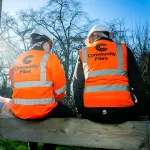New Government Changes to Boost 5G Mobile Cover in England

The Government has today begun a consultation on their proposed changes to Permitted Development (PD) rights for mobile infrastructure, which seeks to extend 5G and 4G (mobile broadband) coverage in rural areas of England via key changes (e.g. allowing taller masts of up to 30 metres and softening planning permission).
At present all the major Mobile Network Operators (MNO) – Three UK, Vodafone, O2 and EE (BT) – are in the process of deploying gigabit-capable 5G networks across the country. On top of that the £1bn industry led Shared Rural Network project (inc. £500m of public investment) is also working to extend geographic 4G coverage to 95% of the UK by the end of 2025, which may also aid future 5G coverage.
However, in order to ensure that all of this is successful the Government must first tackle some well-known problem areas, which have tended to make it difficult for operators to expand mobile coverage in a cost-effective way.
Advertisement
In simple terms, they need to make it easier for operators to improve existing masts, or to build taller masts and related infrastructure, which means expanding PD via changes to the Electronic Communications Code (ECC).
On top of that the Government (DCMS) will also produce a new Code of Practice (CoP) for mobile operators, which will inform them on how they and local authorities can “work together to build communications infrastructure the country needs“. It will also contain best practice for the siting of new infrastructure, particularly in protected areas, and “ensuring stakeholders are properly consulted.”
Proposed Reforms to PD Rights in England:
➤ Existing mobile masts to be strengthened without prior approval, so that they can be upgraded for 5G and shared between mobile operators. This would allow increases to the width of existing masts by up to either 50% or two metres (whichever is greatest), and in unprotected areas allow increases in height up to a maximum of 25 metres (previously 20 metres). Greater increases will also be permitted subject to approval by the local authority.
➤ New masts to be built up to five metres higher – meaning a maximum of 30 metres in unprotected areas and 25 metres in protected areas, subject to approval by the planning authority.
➤ Greater freedoms for slimline ‘monopole’ masts up to 15 metres in height, which are less visually intrusive than standard masts and used for 5G rollout, in unprotected areas. This could mean operators notifying local authorities of their intention to proceed without needing prior approval. This would align it with current rights that telecoms operators have for telegraph poles.
➤ Building-based masts to be placed nearer to highways to bring better mobile coverage to road networks, subject to prior approval, and in unprotected areas smaller building-based masts to be permitted without prior approval.
➤ Cabinets containing radio equipment to be deployed alongside masts without prior approval and to allow greater flexibility for installing cabinets in existing compounds – fenced-off sites containing masts and other communications equipment – to support new 5G networks.
At present 25 metres (height) is currently the legal limit in England for mobile masts / towers (it’s even lower in some parts of the UK, such as Wales), but outside urban areas operators would also like to build even taller masts because this is one way to significantly boost coverage, while keeping costs down. Around the EU a lot of countries have a 50m limit, while 25m also seems increasingly redundant in today’s era of towering wind turbines.
Sadly, the Government have not opted to go as high as 50 metres, which will be seen as a disappointment by some. Nevertheless, going up to 30m is still going to deliver a boost, even if that boost is much more modest. According to Ofcom (here), increasing a mast’s height from 15m to 20m can boost the coverage it provides by 10%, while going from 20m to 25m can increase that by a further 19% and so forth.
Advertisement
Now, before the usual mobile health fears start, it’s worth pointing out that taller masts actually put the radio equipment even further away from people on the ground (safer). Likewise, having taller masts means that you need fewer small masts, which is another bonus on this front and may soften the cosmetic impact in some areas. But it’s currently unclear how many smaller masts may be removed with a boost to 30m.
Oliver Dowden MP, UK Digital Secretary, said:
“We want to level up the country and end the plague of patchy and poor mobile signals in rural communities.
Today we are setting out plans to make it easier for mobile firms to transform connectivity in the countryside and propel villages and towns out of the digital dark ages – providing a welcome boost for millions of families, businesses and visitors.
These practical changes strike a careful balance between removing unnecessary barriers holding back better coverage, while making sure we protect our precious landscape.”
Hamish MacLeod, Director of Mobile UK, said:
“We welcome the proposals set out in this consultation which will provide better certainty and flexibility to technological changes required to build world-class mobile networks. We urge the Government that to assist mobile companies to meet its ambitious targets for deployment, it brings about legislative change as quickly as possible.”
The rule changes will of course also make it more difficult for people to object to the deployment of new masts and related upgrade work to existing masts, in certain circumstances. Local councils will thus have a tricky time of trying to balance these changes with pressure from their constituents. Not everybody likes having new telecoms infrastructure built near their property and objections to planning applications can be quite common.
The new CoP proposed above is unlikely to resolve all of those disputes and indeed we have doubts about the ability of these changes to, as the government pledges, “eliminate mobile signal blindspots in rural areas and on roads.” Inevitably there will always be some areas where mobile signals will struggle to reach, whether due to terrain topography or other physical obstructions (buildings, forests etc.).
All of this might also help to support the Government’s new £5bn Project Gigabit commitment to rollout gigabit-capable broadband across the final 20% of the hardest to reach premises (mostly rural) by the end of 2025, since some of that same mobile infrastructure may play a part – either directly or indirectly – in supporting such connectivity.
Advertisement
The consultation on these changes will run for eight weeks and closes on 14th June 2021. On top of that the Government have today also published a final report from the Telecoms Diversification Taskforce (TDT), which broadly sets out how the Government should seek to support new suppliers into the mobile market (e.g. fostering OpenRAN) in order to replace the loss of Huawei (context here and here).
TDT Recommendations
➤ Working through telecoms standards-setting bodies to encourage best practice in security and open networks;
➤ Creating the right environment for diversification through policy interventions – for example, setting out a timetable for the winding down of 2G and 3G networks to support the entry of new vendors into the UK market;
➤ Identifying interventions and investment to accelerate the development and adoption of Open Radio Access Network technology, including setting up a fund for developing new products and ensuring testing facilities such as the UK Telecoms Lab and SONIC meet industry needs;
➤ Identifying opportunities to invest in long-term research and innovation to build UK capability for current and future generations of telecoms technology.
The point about setting a timetable for withdrawal of 2G and 3G networks is going to be very tricky. In fact, it’s probably easier to do this for a standard like 3G than it will be for an established and still widely used one like the older 2G service, which has found plenty of low powered niches. For example, the original SMETS 1 energy smart meters all made use of 2G signals to send their readings.
Otherwise, the final report into this £250 million strategy is fairly generalised and doesn’t add much that we didn’t already know, which means that we’ll have to wait until the Government issues its formal response in order to find out what practical changes will result from those proposals.
Changes to PD Rights – Consultation
https://www.gov.uk/../changes-to-permitted-development-rights-for-electronic-communications-infrastructure-technical-consultation
Telecoms Diversification Taskforce – Final Report
https://www.gov.uk/../telecoms-diversification-taskforce-findings-and-report
Mark is a professional technology writer, IT consultant and computer engineer from Dorset (England), he also founded ISPreview in 1999 and enjoys analysing the latest telecoms and broadband developments. Find me on X (Twitter), Mastodon, Facebook, BlueSky, Threads.net and Linkedin.
« CityFibre and Telent Start Blackpool’s Gigabit Broadband Rollout
New Virgin Media UK Trial Hits 2.2Gbps Broadband Speed AGAIN »























































Feels like a missed opportunity on height. Limited gains.
It wouldn’t be Britain if it wasn’t half assed.
Oliver Dowden talks a good talk, but the guy is just like the rest of his colleagues, completely out of his depth.
About time! Now watch the protestors against this come out of the woodwork, who usually are the very same people who moan about not having any mobile phone signal..
I look forward to 5G being spread across the country. And 4G being given a significant boost. But we will have to see how it is acted on in real terms. See what resistance from various country alliance groups the plans face.
I thought 5G required more masts due to the shorter range.
So surely the argument that the additional 5m requires fewer masts is counter to aiding 5G rollout ?
The distance 3.4 to 3.8ghz band delivers isn’t much of a big difference from 2.6 or 2.1ghz that some of the operators use.
We don’t have the mmWave frequencies available in UK yet. Ofcom haven’t set an auction date either.
But an extra 5G mast for better indoor signal would probably be needed.
I live in Wales & the hight restrictions are stupid & old. It’s great to see England updating their hight restrictions. Though I don’t think 30meters is enough.
People do forget that the higher the mast the bigger the coverage circle.
Good. Sick of our local council denying 5G masts. One they denied next to me saying it would “spoil the view” yet the view was of an industrial estate. Also sick of the anti-5G brigade protesting and complaining about masts being put up that spread “pulsed radiation” and harm our health etc and the local lib dems are pandering to them, it’s unbelievable. Yet openreach are free to stick their telegraph poles where they like and they don’t require planning permission, but mobile networks have to beg local councils for permission to give us better internet/mobile signal.
why can’t 5g antenna be put on telegraph poles anyway? It’d certainly make it cheaper to deliver, especially with fibre already on a lot of them. Apparently BT has a few 9M poles they don’t want to publicly associate with 5G.
Why not 5G on phone poles? Would impact FTTP capacity and provisioning to the home, that’s why.
Might be OK in a few niche cases, but generally could crowd out other connectivity needs.
https://www.thinksmallcell.com/Metrocells/every-telegraph-pole-across-uk-now-a-potential-outdoor-small-cell-site.html
Was a good idea back in 2014, would be an even better solution in 2021.
Only seems like yesterday when Mobile Broadband Network Limited and Cornerstone were boasting how many thousands of masts they cut.
True but to be honest I don’t see UK operators erecting many new masts, they may well extend/replace some under these new rules but extending 5G coverage will be left to utilising low band spectrum and femtocells in built up areas and infrastructures (as they already do)
I’d rather they just focus on 4G, it provides more than enough speed.
It would if the carriers actually delivered it properly, but if they did who’d sign up for 5G contracts?
There is so much hype around mobile networks at the moment, seems to be a lot of expectation of loads of new masts and cells being put up everywhere but the reality in the UK will not be this from what I’ve gathered and can see.
Extending coverage is going to be done the same way it was with 4G, which is by utilising lower band spectrum, networks don’t seem to be looking at erecting new masts for 5G but rather just to continue extending or densifying coverage across the country for 4G and adding 5G to masts along the way.
Area’s where 5G is aimed to make the most impact will using the same methods as currently used with 4G be done by installing femtocells inside buildings/arenas/underground.
The reality many need to note to is, coverage won’t be a huge issue as the networks are already merging ‘so called 5G’ into existing 4G spectrum using DSS.
True 5G (Standalone) is many many many years away and even then will be something that will not be something focused on consumers via devices but much more directed towards IoT and automation.
It’s worth noting that while 5G might be the headline currently, operators network departments are still more concerned about getting 4G coverage in place and re-farming spectrum to the right places before moving forward properly with 5G….. however they are also very keen to give users that little 5G icon in the corner of their screens (by whatever means necessary) to up-sell new devices and plans of course.
Can’t utilise lower frequency with a hill in the way! Too many hills and valley’s in my area, networks know that, but have been stopped by protests and the usual Council “Its AONB so its not happening” Its very hit and miss, and its hypocrisy, how can you allow masts in some areas be built 20m high lattice towers too in AONB, but reject 8m high Telegraph pole style one, on grounds it would be out of place in a line of existing Telegraph poles.
I know right ?
I’ve just been looking at planning applications in my area and gotta give it to Three, they’ve made about 15 applications since August last year and only about 4 have been approved, some of those applications are long overdue and needed implementations but the council have refused them all on the same rubbish reason.
This is urban Birmingham area too, so can’t see the reason behind it.
Can’t say I found any new mast planning for any of the other networks but did find a couple of upgrade applications (no permission needed) for existing masts.
Three seem to be going in a new direction with their network and installing their own masts again.
Upgrades here need planning permission, adding a new equipment cabinet and different array, probably because its AONB, which I use loosely, some areas of the Cotswolds are very picturesque, but since this area is the Headquarters for “Extinction Rebellion”. Then we’re pretty much shafted.
Cabinets are an assortment of different size, shape and colour boxes. This needs sorting, looks a mess.
This video is a good way to understand current 5G standing!
https://www.youtube.com/watch?v=CgeyeuY8KZM